|

COLD WAR ENCOUNTER
Adventures from the later years of the U.S.S. CHEVALIER (DD-805)
As Recorded By Fred Albrecht, RM2, 1969-1972
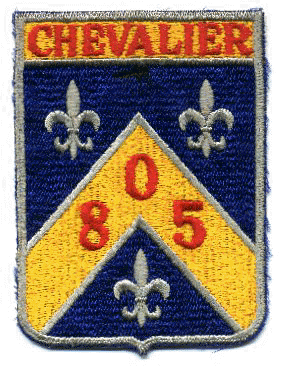 This story takes place after the Chevalier returned from my first Westpac
cruise. We got back to San Diego in
early September of 1969, to the great relief of everyone on board. It had been a
tough cruise, and the crew was looking forward to some long needed R & R.
The Chevy went into post-cruise mode, with many of the crew either
getting out of the Navy, getting transferred, or going on leave.
This story takes place after the Chevalier returned from my first Westpac
cruise. We got back to San Diego in
early September of 1969, to the great relief of everyone on board. It had been a
tough cruise, and the crew was looking forward to some long needed R & R.
The Chevy went into post-cruise mode, with many of the crew either
getting out of the Navy, getting transferred, or going on leave.
Making Third Class
During this period, an event happened that I had been
looking forward to for some time. On
October 16, 1969 (my birthday), I got the best birthday present of all in being
able to put on my Third Class crow! RM1
Adam Malek had asked me when I was going up for 3rd class “Are you
ready for the responsibility of being a petty officer in the United States
Navy?” I gulped and had to think
a few seconds before answering “Yes”. I
had never been responsible for anything before in my life!
I had passed all the tests for RM3 in Westpac, and had been waiting
expectantly for my advancement to take effect.
I’m sure all of you can remember what a great moment it was, and it
still stands out in my mind as one of the greatest transition of my life.
Overnight, I went from a subhuman peon/indentured servant to someone who
might actually be considered semi-intelligent.
No more mess-cooking or scullery details, plus the opportunity to get out
of a lot of working parties! Hallelujah! The
Navy might actually be fun!
On the way back from Westpac (after we left 7th
fleet), RM1 Malek had put the three RMSN’s in one watch section.
The objective was for us to learn as much as possible, and to get some
experience operating on our own. The
other two RMSN’s weren’t interested in sitting out front in Radio Central
and dealing with the demands of running a radio watch section, so it kind of
fell to me. All three of us were
clueless, but managed to muddle through somehow.
Lots of Changes on the Chevy
From September through October of 1969, there were many personnel changes on
the Chevalier.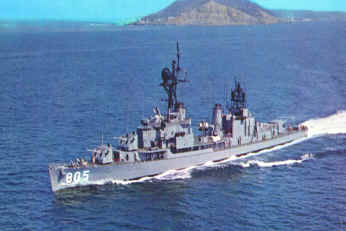 The most important was that we got a new commanding officer, Commander
William T. Greenhalgh, who replaced Commander Palletini.
Commander Greenhalgh turned out to be the best Captain that we had during
the time I was aboard. He was a
great ship handler and an approachable human being. The officers in the wardroom all thought highly of him, and
appreciated the fact the he took the time to pass on his knowledge and
experience to them.
The most important was that we got a new commanding officer, Commander
William T. Greenhalgh, who replaced Commander Palletini.
Commander Greenhalgh turned out to be the best Captain that we had during
the time I was aboard. He was a
great ship handler and an approachable human being. The officers in the wardroom all thought highly of him, and
appreciated the fact the he took the time to pass on his knowledge and
experience to them.
In all departments of the ship, many people were leaving.
In the radio shack, we lost most of the people who had made the 1969
cruise. One RM2 got out, while the other RM2 shipped over and was
transferred to the East Coast. All three experienced RM3’s got out.
RM1 Malek went on leave before being transferred.
Most of the other departments experienced similar attrition.
Since there only a few people left in the radio shack, it seemed like a good
time for me to take leave. I
figured that the ship wouldn’t be going anywhere until we got some
replacements. On October 30, I left
for two weeks leave in Ohio.
Unexpected Assignment
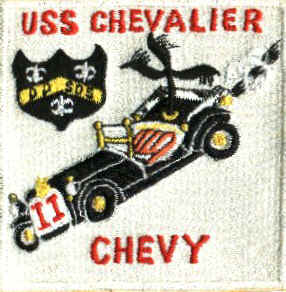 When I returned to the ship on the evening of November 11, I was surprised to
see that the boilers were fired up and the Chevy was building up steam.
On the quarterdeck, RMC Broughton told me that we were getting underway
at 7:00 AM in the morning and to report to Radio Central immediately.
I went up to Radio Central, where I found a flustered RM3 Dwight Nelson
struggling to bring up all the required circuits. His first words were “Boy, am I glad to see you!”
He had been dreading the prospect of going to sea as the only radioman
PO, beside Chief Broughton. I suddenly realized what was happening, and felt my stomach
kind of drop out. We were going to
have to go to sea with two green RM3’s and four RMSN’s, while RMC Broughton
was more of a teletype repair specialist! A
rapid series of thoughts went through my mind that were something like – “Oh
Shit!”, “No options!”, “I’ve got to do this!”
I remembered RM1 Malek’s question to me about responsibility.
I had not been ready for so much responsibility quite so fast.
I was not a particularly religious person at that time, but I remember
saying a prayer that I wouldn’t screw up!
Nelson and I split up the four RMSN’s into Port and Starboard watch
sections, and started our at sea watches right then.
When I returned to the ship on the evening of November 11, I was surprised to
see that the boilers were fired up and the Chevy was building up steam.
On the quarterdeck, RMC Broughton told me that we were getting underway
at 7:00 AM in the morning and to report to Radio Central immediately.
I went up to Radio Central, where I found a flustered RM3 Dwight Nelson
struggling to bring up all the required circuits. His first words were “Boy, am I glad to see you!”
He had been dreading the prospect of going to sea as the only radioman
PO, beside Chief Broughton. I suddenly realized what was happening, and felt my stomach
kind of drop out. We were going to
have to go to sea with two green RM3’s and four RMSN’s, while RMC Broughton
was more of a teletype repair specialist! A
rapid series of thoughts went through my mind that were something like – “Oh
Shit!”, “No options!”, “I’ve got to do this!”
I remembered RM1 Malek’s question to me about responsibility.
I had not been ready for so much responsibility quite so fast.
I was not a particularly religious person at that time, but I remember
saying a prayer that I wouldn’t screw up!
Nelson and I split up the four RMSN’s into Port and Starboard watch
sections, and started our at sea watches right then.
The Chevalier had been assigned the task of locating and
tracking a Russian trawler that was observing our missile launches from
Vandenberg Air Force base. When Captain Greenhalgh had been given the message
containing our orders, his response was “They’re f__king with me already!”
Finding our Adversary
The next morning, the short-handed ship got underway on
schedule. The day started out as a
typical San Diego morning, foggy and overcast.
However, it quickly changed to a beautiful autumn day.
The skies were clear and the seas calm for our trip up the coast to Point
Conception/Point Arguello, where our Russian adversary was hanging out.
The word to describe the Chevalier at this moment in time was “NEW”.
We had a new CO, a new operations officer (Lt. Lopachinski), a new
engineering officer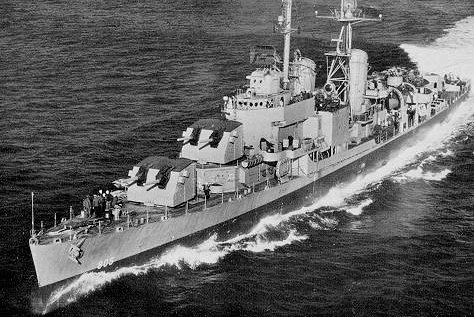 (Lt. Stillmaker), and a new communications officer (Ltjg Eimstead).
All departments were low on personnel.
(Lt. Stillmaker), and a new communications officer (Ltjg Eimstead).
All departments were low on personnel.
We proceeded up the coast and were treated with a really
pleasant day at sea with blue skies and blue water, passing through the Santa
Barbara channel. We located our
target around 4:00 PM in the afternoon. We
wouldn’t have really needed to use radar.
In fact, we wouldn’t really have needed to use binoculars either.
The “trawler” turned out to be a Soviet Navy surveillance ship that
was the size of a cruise liner!
The Soviet ship was big, and had three
huge white domes fore, amidships, and aft.
These domes covered sensitive radar antennas and surveillance equipment.
The ship’s hull was an odd colored brownish-green.
The Russian’s purpose for being there was to observe and record our
military missile and satellite launches from Vandenberg Air Force Base, which
was just inland. At that time, many
test launches of our Minuteman ICBM’s (Intercontinental Ballistic Missiles)
were happening. The Soviet ship did actually carry some token fishing
equipment. This was so they could
use the B.S. excuse that they were only an innocent trawler.
We took up station near the Russian ship, and began to record their
activities by taking pictures and using our ECM gear to monitor their
transmissions.
Keeping Things Running
The Chevalier settled into a routine of looking at the
Russians while the Russians looked back at us.
All the crew was working hard to do a good job, and many of us were doing
things we had never done before. In
the radio shack, we were responsible for sending out “SITREPS” (situations
reports) every four hours. This was
along with all the other myriad incoming and outgoing messages typical to at-sea
operations. Thank God, we were half
way between the Naval Communications stations in San Francisco and San Diego, so
our communications were good.
The weather got much rougher and more November like.
The Chevy bounced around (as usual) in the heavy seas.
The Russian ship, on the other hand, was equipped with underwater
stabilization fins. They didn’t
seem to roll or pitch much at all. This
feature was due to the sensitive nature of the crappy Soviet electronic
equipment they carried.
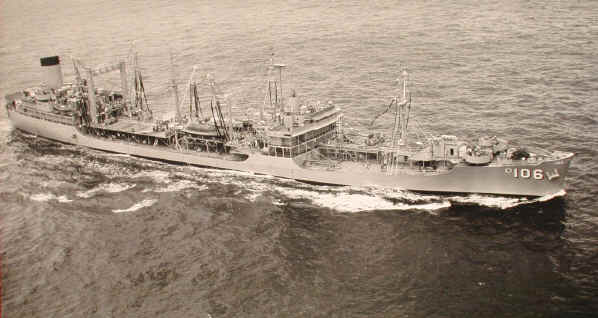 We kept up this constant surveillance of the Russian craft, leaving only for
periodic refueling from the local fleet oiler (probably the U.S.S. Navasota
AO-106-seen left). After a
couple of weeks of this, another unfortunate destroyer relieved us.
We kept up this constant surveillance of the Russian craft, leaving only for
periodic refueling from the local fleet oiler (probably the U.S.S. Navasota
AO-106-seen left). After a
couple of weeks of this, another unfortunate destroyer relieved us.
Returning to San Diego
The ship pulled into San Diego in the evening, with the
tired crew just happy to either get some sleep or to get totally hammered.
The Captain gave us all a “Well Done”.
Even though most of us had not particularly enjoyed this little jaunt, we
had all gotten a lot of experience by doing it.
If you can attach any exalted or enlightened reasoning to anything that
Naval Command ever had us do, then this was what they had in mind for us.
I certainly felt a lot more confident in my abilities as a radioman.
I have to thank my primary mentors (RM1 Adam Malek and RM3 “Ace”
Hawkins) for giving me the training that allowed me to pick things up and do
what was required.
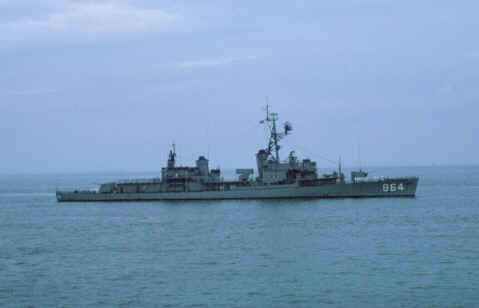 I experienced something else which at the time seemed unusual.
Things in Radio Central had been somewhat stressful, and on every watch I
was doing something I had never done before.
Even with all my usual cussing and complaining associated with being in
the Navy, I found that I couldn’t think of anywhere else that I would rather
be than right there where I was. For
the first time in my life, I felt I was doing something that was important.
I experienced something else which at the time seemed unusual.
Things in Radio Central had been somewhat stressful, and on every watch I
was doing something I had never done before.
Even with all my usual cussing and complaining associated with being in
the Navy, I found that I couldn’t think of anywhere else that I would rather
be than right there where I was. For
the first time in my life, I felt I was doing something that was important.
As always, I would enjoy hearing from anyone who served on the Chevy during
the period I was aboard. My phone
number is (707) 664-8256, and my E-Mail is startrek805@aol.com
Thanks Shipmates,
Fred
Albrecht

 

|
